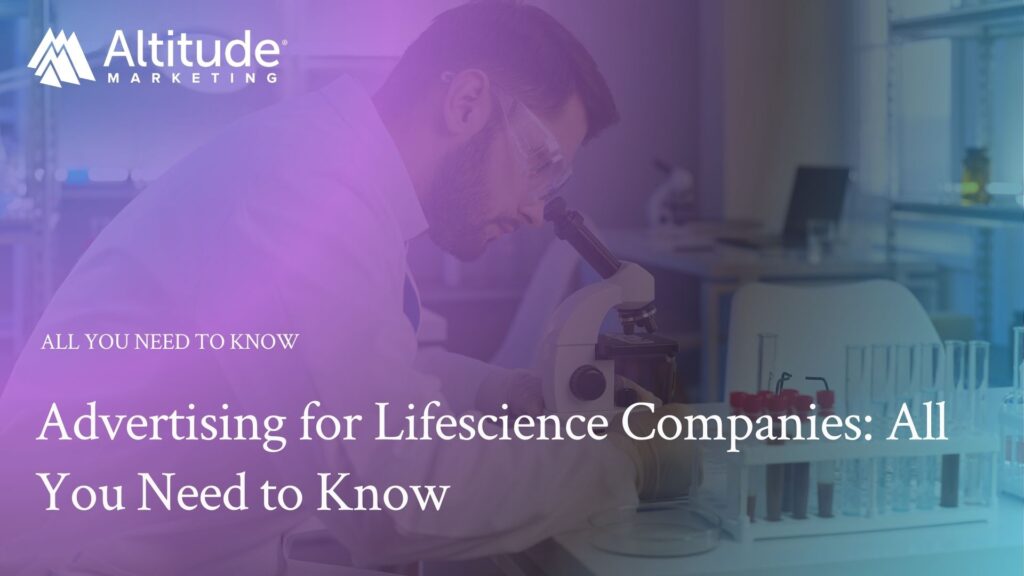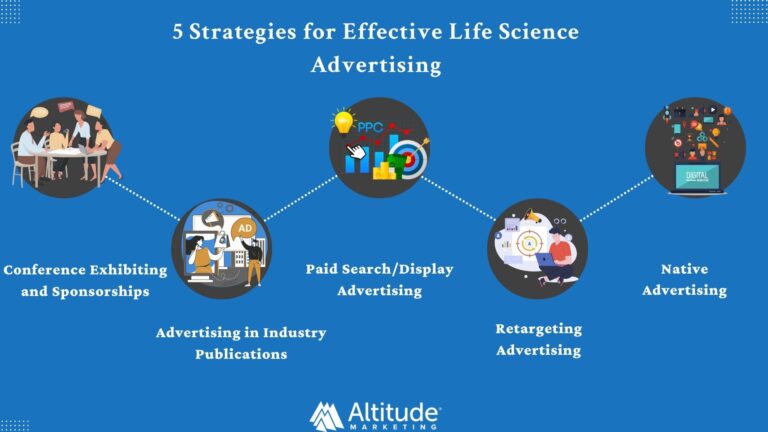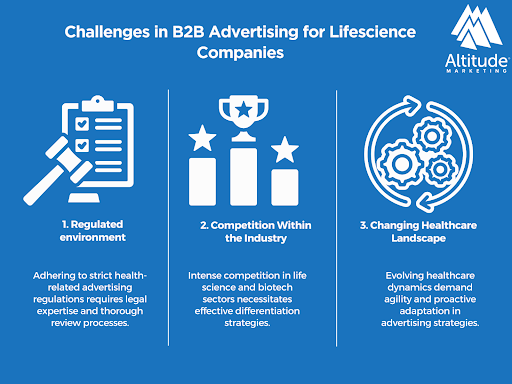Quantity is easy in paid advertising. Invest enough money and you can build massive reach. But for B2B Life Sciences companies, quantity is irrelevant. You aren’t looking for a lot of impressions. You need the right ones. That’s why an effective paid media strategy is so difficult. It involves understanding your target audience, differentiating yourself from competitors and engaging with prospects across various platforms. This article will explore the advertising tactics necessary for success in B2B life science.

Overview

Understanding B2B Marketing in Life Sciences
In 2022, B2B paid media spending reached $32 billion. That staggering amount shows just how valuable a well-executed strategy can be, even when sales cycles are long and lead volume is small. For Life Science companies looking to grow brand recognition and lead pipeline revenue, paid strategies (done right) can reap enormous rewards. But unlike D2C marketing, those dollars need to focus on niche content strategies, including:
- Professional trade shows and conferences
- Educational webinars
- Direct marketing campaigns
- Content marketing incorporating industry insights
- Strategic partnerships and affiliate programs
Your goal should be to build experience, authority, and trust in your industry. Long-term, that should come through organic efforts. But paid media can be an excellent launching point when you need to cover ground quickly.
5 Effective Paid Advertising Strategies
Before launching any paid campaign, you and your team need to align on two essential parameters: 1) The goals of the campaign and 2) The overall budget. With that in here are 5 tactics that vary in both cost, agility, and target audience.
| Advertising Strategy | Budget Allocation | Buyer Personas | Time to Impact |
| 1. Live Events and Tradeshows | Moderate – High | Sales leaders, Marketing VPs, Clinical Directors | Immediate (during event) |
| 2. Print Advertising in Industry Publications | Moderate | Scientists, Researchers, Healthcare Providers | Weeks to Months |
| 3. Paid Search/Display Advertising | Moderate | All roles – personalized based on keywords | Days to Weeks |
| 4. Retargeting | Low – Moderate | All roles – based on site behavior | Days to Weeks |
| 5. Native Advertising | Moderate | C-suite Executives, Procurement Officers | Weeks to Months |

1. Conference Exhibiting and Sponsorships
Advertising for life science and biotech companies often involves conferences, trade shows, and live events to connect with your target audiences. Conferences and industry trade shows provide excellent opportunities for direct engagement with healthcare decision-makers and leaders through exhibit sponsorships and on-site promotion. By interacting face-to-face with individuals, your company can showcase thought leadership, convey important messages, and build valuable relationships. Allocate a portion of your budget towards solidifying your position in the industry and accelerating pipeline growth. Live events also cater to a wide range of budgets. Whether you simply attend or you pay to be a marquee sponsor, your engagement is flexible based on your goals.
Don’t discredit the value of virtual conferences. By going digital, more people can attend from anywhere without needing to travel. Live video sessions and chat features can recreate the feel of in-person events. Presenters can easily share slides and product demos to keep the audience engaged. Data and metrics provide insights into who is tuning in and what content is connecting with them. Networking may look different, but meaningful connections can still be made.
2. Advertising in Industry Publications
In addition to channels that allow precise targeting and attribution, it is still valuable to include print ads in respected medical journals and industry publications. This enables engagement with influencers who rely on these mediums. To capture readers’ interest use striking creative content and compelling calls to action. It is important to monitor responses over months to evaluate the effectiveness among different subscriber segments.
3. Paid Search/Display Advertising
While organic SEO tactics that boost visibility are always more effective in the long term for engagement, paid search advertising is an immediate option to appear at the top of targeted keywords.
Life science companies bid in advertising auctions to showcase their content. The top bidder gets the best ad spot. Prices change based on demand for a specific keyword. More interest means higher ad rates. The good news for B2B companies? The most valuable keywords in your industry likely do not have a large volume. That means you can find great value while targeting your specific, niche audience.
4. Retargeting
Say you visit a website about meditation. Later, you may see ads for meditation pillows and calming teas on other sites. This is retargeting. Retargeting happens when ads follow you around the web. Retargeting in the B2B world is trickier than D2C, but it can still pay dividends when done on niche/industry-specific sites or on social networks like LinkedIn.
Retargeting can help you:
- Engage a target user multiple times, creating a persistence loop
- Reinforce your brand identity
- Track how exposure leads to real sales
Companies pay each time their retargeted ad is displayed. Rates vary based on the specific website’s traffic and audience. Success depends on where and how you choose to target, so ensure you do plenty of research on related industry websites before launching a new campaign.
5. Native Advertising
Native ads don’t pop out like banners or videos. They blend into online content naturally. For example, an article titled “5 Exercises to Strengthen Your Heart” may promote a cholesterol drug inside it.
Life science companies use native ads to educate and build authority. The ads match the style and topic of the content around it. This makes them less disruptive and easier to read. This also makes them more expensive than traditional digital or programmatic campaigns.
But, done effectively, a native ad campaign will:
- Leverage the authority and trust of the publication in which the campaign appears
- Reach a highly-engaged audience
- Provide highly engaging, education content that doesn’t include aggressive sales CTA’s.
Unlike programmatic or search ads, there’s no central marketplace to execute native ads. To get started, you will need to identify and then contact the specific industry publications that align with your audience and brand identity.
Challenges in B2B Advertising for Life Science Companies
The landscape of B2B marketing in the life science and biotech industries is undeniably promising, but it’s not without its set of challenges. These challenges require strategic approaches and innovative solutions to navigate effectively. Here are some of the key hurdles faced by life science companies in their paid media strategy:
1. Regulatory Hurdles
The life science industry operates within a highly regulated environment. Adhering to regulatory requirements and compliance is paramount. Health-related advertising must meet stringent standards to ensure accuracy and patient safety. The complexity of regulations can pose challenges in crafting and executing advertising campaigns that resonate with the audience while staying within legal boundaries. Companies must invest in legal expertise and thorough review processes to overcome this hurdle.
2. Competition Within the Industry
The life science and biotech sectors are highly competitive. With numerous companies vying for the attention of a small, niche audience, breaking through the noise can be challenging. It’s essential to differentiate your brand and offerings effectively. This involves not only showcasing the scientific excellence of your products but also conveying a compelling value proposition that sets you apart from competitors.
3. Changing Healthcare Landscape
The healthcare industry is continually evolving, influenced by factors such as technological advancements, shifting patient demographics, and changes in healthcare policies. Keeping up with these changes and adapting your advertising strategies accordingly can be a significant challenge. Staying relevant and addressing emerging trends, such as telemedicine and personalized medicine, requires agility and a proactive approach to advertising.
Despite these challenges, B2B advertising in the life science sector presents immense opportunities for companies to make a meaningful impact on patient care and scientific advancements. By understanding these challenges and developing strategies to address them, life science companies can navigate the complex landscape and drive success.

How to Measure Success
Because paid advertising requires real dollars to execute, it’s crucial that you monitor success during and after every campaign. That way, you can improve or pause efforts that are not achieving your goals.
1. Scientific Engagement Metrics
Conduct pre- and post-campaign surveys with researchers downloading assets to capture key motivations and takeaways. Set monthly benchmarks for download volume aligned to awareness phase content types. Also, track researcher satisfaction and open rates for follow-ups. This identifies content resonating to expand reach.
This requires taking three steps:
- Set goals before launching. Know exactly what success means.
- Monitor campaigns as they run. You can burn through a spend quickly, so ensure your dollars are working as they should.
- Conduct a Post-Mortem: After each campaign, you should evaluate what worked and what didn’t. This helps guide your next effort and helps build a constant culture of refinement on your team.
Conclusion: An Integrated Marketing Approach for Life Science Leaders
Paid advertising is a quick way to grow brand awareness and generate leads. But it’s only one tool you should lean on in your overall marketing strategy. Solely focusing on advertising risks losing authority, trust, and expertise in your industry. Plus, you’ll burn cash quickly without seeing long-term ROI. Your budget is not limitless, so ensure you constantly optimize and refine your strategy to make every dollar work its hardest.



